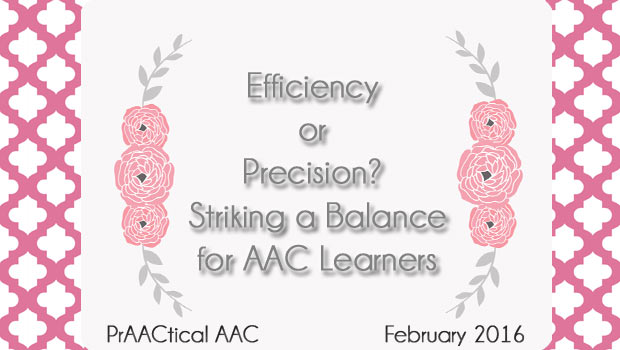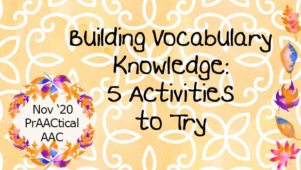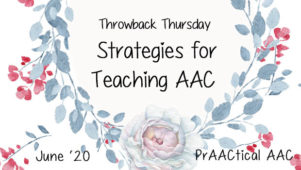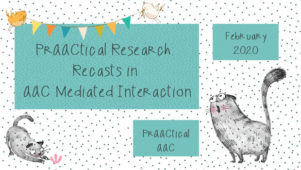Efficiency or Precision? Striking a Balance for AAC Learners

Elliott has been using some form of high tech AAC since he was in kindergarten and can express wants/needs easily. Though his language is simplistic compared to his 5th grade peers, he is able to use his SGD to give opinions, explain them, ask questions, engage in small talk, and tell short narratives. His SLP has targeted skills in inferencing, use of prefixes (‘un’ and ‘re’), verbal reasoning, Tier 2 vocabulary, and embedded clauses to help Elliott acquire the language skills that will allow him to be more successful in his academic work. She is keenly aware that, as he transitions to middle school, the academic and social demands on him will increase significantly.
Although Elliott can spontaneously produce 9-12 word sentences, he usually communicates in short, simple utterances. In a recent interaction he used a single word, ‘good,’ to describe a video, and a short sentence (‘I was mad’) to tell about an event.
In both cases, Elliott’s clinician knows that he was fully capable of using more sophisticated vocabulary and producing more complex sentences. She also knows that the cognitive, linguistic, and motoric effort it takes Elliott to use his ‘best language,’ is considerable.
The question she wrestled with is familiar to many of us: When do we accept simple yet effective utterances, and when do we push for clients to use more advanced language?
The answer is highly variable, of course, depending on the client and the circumstances. Here are some thoughts to consider as you work through those decisions with your own AAC learners.
“When should we prioritize efficiency?”
Saying something in a single word or short sentence can be effective and efficient. If you ask me where the door is, for example, I’m more likely to point and say ‘right there’ than I am to say ‘It is approximately 90 degrees over my left shoulder.’ Both are correct. Both are effective. But when you consider the amount of time and effort it takes to produce each one with an SGD, it is apparent that the first one is much more efficient. Using more language, like in the second example, doesn’t really have a better pay-off than the short, simple version.
Efficiency is hugely important to AAC learners. Knowing how to communicate in the most efficient way is a valuable skill that we should teach and reinforce. We should consider targeting less-than-top-ability when:
- it effectively conveys what the communicator is trying to express;
- the focus is on the exchange of information;
- it is the norm for the context;
- communication needs to happen quickly;
- the learner is exceedingly distressed; and,
- the skill is difficult and the learner is tired, distracted, or stressed.
“When should we prioritize more advanced or precise language?”
The problem, of course, is that the more we use simple language, the less likely we are to get better at using more advanced language.To make linguistic expression faster and easier, our AAC learners need lots of practice. Are there times when we accept language that is less than our client’s best? Absolutely. But to help them become more linguistically competent, we have to balance that against times where we press them for more advanced or precise language. Consider prioritizing more sophisticated language when:
- quick communication is not essential;
- simpler language doesn’t effectively convey what the communicator wants to express;
- the focus of the interaction is on language teaching of a particular skill;
- the skill is difficult, but the partner is able to support the process; and,
- the learner signals a preference for this format.
The struggle to find a balance between efficiency and precision is part of the language teaching process that most AAC interventionists face. Like so many things in AAC teaching, it isn’t all one or the other. If you’ve wrestled with this dilemma and have thoughts or suggestions, please add to the conversation on this topic. We’d love to hear what has worked or not worked with the AAC learners you know.
Filed under: Featured Posts, PrAACtical Thinking
Tagged With: interaction, language intervention
This post was written by Carole Zangari





3 Comments
This is a daily struggle in the life of an AAC clinician. When and how do you push for more? I have had some success with register lessons. When we are with our friends we often use a different register as compared to when we speak with work colleagues. Some sessions were spent acknowledging quick, efficient communication by pairing off students armed with a rubric to rate their exchanges. Were they quick? Were they clear? Other sessions were spent teaching that the best way to show the world you are knowledgeable about a subject is to use precise, accurate language. I think when you package it as a lesson in demonstrating to others what you know rather than the tedious task of making the speech lady happy with a long sentence, you can get a bigger buy in. Plus, it helped me stop saying “use a longer sentence”!
Personally I think the best test is whether the communication is complete enough that the receiver understands and does not have to infer meaning. I think it is a disservice to the AAC learner when we guess and fill in the blanks for them. As a parent it is easy to fall into this habit because it’s easier and faster (and we often know what they really mean). It doesn’t ever make sense to demand a more complex reply from an AAC user than you would expect from a speaking person, like in the door example. But if door is down the hall and to the right can the AAC user say that? I can think of a lot of instances where my daughter has tried to use a single word to convey a more complex idea, such as saying “boots” when she wants to wear her boots to school instead of her AFOs. I would ask for her to say “I want to wear boots.” dropping “to school today” is okay because it’s implied, but simply saying boots shouldn’t be okay even though I knew perfectly well what she wanted. In that instance I might say “I like your boots too.” to which she will shake her head no since that isn’t what she meant. At that point I would either verbally prompt her to say the words or model it. Since I’m not a therapist I can’t say what would be best practice during therapy but I can say that as a parent what I do when I’m focused on AAC teaching is expand the sentences through modeling. An example from this week was that a friend from school told my daughter he would sit with her on the bus and then didn’t so she came home crying. We sat down to “talk about it” . I verbally prompted her to say “I” then “feel” then “sad”. Then I showed her that next time she could use her AAC to say “I felt sad Joe(name changed) you said you would sit with me.” Then I asked wouldn’t it be nice to be able to tell him that with her AAC and she said yes. We worked through the sentence a couple more times and she seemed to feel better and I ended it with saying that next time she could tell him. She nodded in agreement. I don’t know if she will remember all that, but I know the more times we work through more complex expressions the more likely she will be able to do it when it’s important to her. Teaching opportunities come up all day long at school and at home. Therapy sessions are different by nature. In the example of Elliott maybe the strategy might be to model a more complex sentence that guesses what he might really think or feel, and follow by asking Elliott if she is right or not. Maybe he might reply by correcting her. Or maybe not. Having 3 kids, two who are typical developing they will most often reply with a short answer. “How was school?” “Fine.” “What did you do?” “Nothing.” For my own daughter the best AAC learning happens when it is new, interesting, fun or gives her power in some way.
Susan, you’ve made some excellent points here. As you point out, therapy is different than teaching opportunities that come up naturally at home, school, and in the community. I think that is such an important message, both for families who may already feel overwhelmed with what they are asked to do by therapists, and for professionals who work with their little ones. Both structured and unstructured interactions can play an important role in AAC learning. Thanks for taking the time to comment and for sharing some beautiful examples.